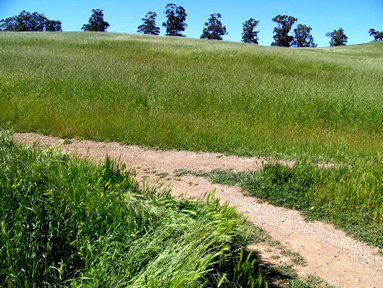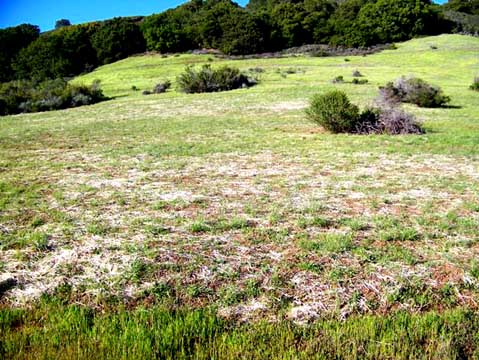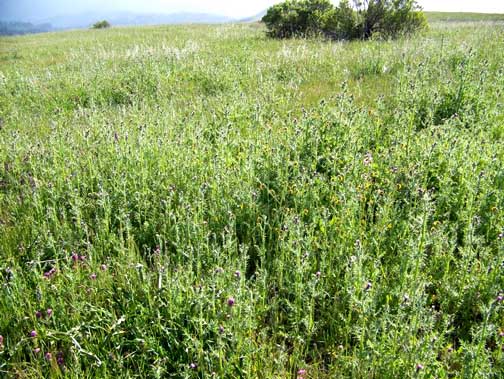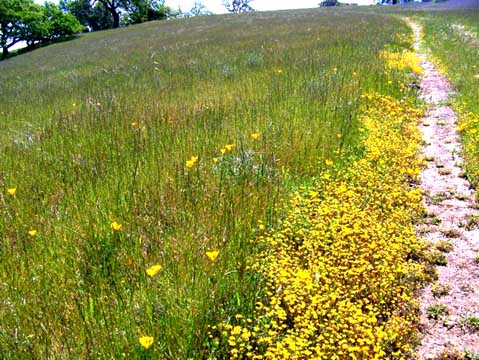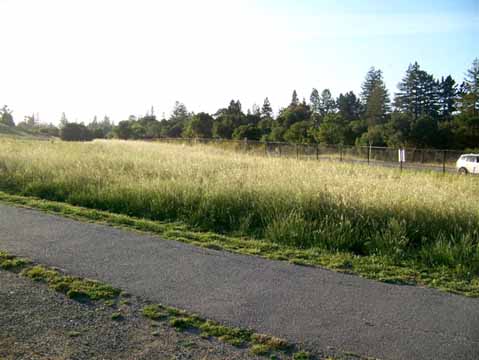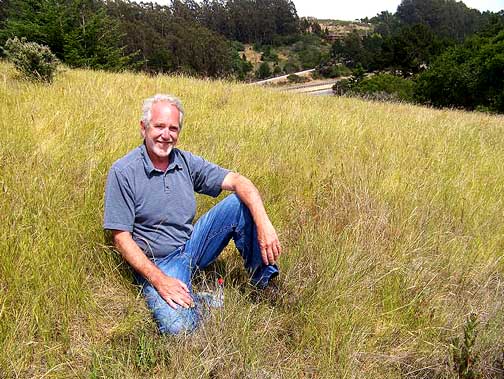|
Site |
Agency land managers |
Date |
Surveyed done by |
Transect paces |
Percent cover
native grasses |
Percent cover wild-
flowers |
Percent cover exotics |
Quality |
Kinds of exotics
or natives
(in italics) |
|
Fremont Older Preserve |
Mid-pen. Open Space District |
8-2006 |
C. Dremann |
100 paces (200 ft.) |
0 |
0 |
100 |
Very poor |
82% Yellow
star thistle |
|
Foothills Open Space |
Mid-pen. Open Space District |
8-2006 |
C. Dremann |
100 paces (200 ft.) |
41 |
39 |
20 |
Very Good |
1% Yellow
star thistle |
|
Long Ridge |
Mid-pen. Open Space District |
8-2006 |
C. Dremann |
100 paces (200 ft.) |
0 |
3 |
97 |
Very poor |
1% Yellow
star thistle |
|
Los Trancos |
Mid-pen. Open Space District |
8-2006 |
C. Dremann |
100 paces (200 ft.) |
10 |
5 |
85 |
Poor |
3% yellow
star thistle |
|
Monte Bello |
Mid-pen. Open Space District |
8-2006 |
C. Dremann |
100 paces (200 ft.) |
2 |
5 |
93 |
Very poor |
53% Yellow
star thistle |
|
Rancho San Antonio |
Mid-pen. Open Space District |
8-2006 |
C. Dremann |
100 paces (200 ft.) |
0 |
0 |
100 |
Very poor |
66% Harding grass |
|
Skyline Ridge |
Mid-pen. Open Space District |
8-2006 |
C. Dremann |
100 paces (200 ft.) |
4 |
26 |
70 |
Fair |
30% Harding grass |
|
Windy Hill |
Mid-pen. Open Space District |
8-2006 |
C. Dremann |
100 paces (200 ft.) |
0 |
36 |
64 |
Fair |
Zero Yellow star thistle and zero Harding grass |
Russian Ridge,
north half |
Mid-pen. Open Space District |
8-2006 |
C. Dremann |
800 paces (1,600 ft.) |
5 |
54 |
41 |
Good |
0.7% Yellow star thistle and 7% Harding
grass |
Russian Ridge,
north half |
Mid-pen. Open Space District |
5-2011 |
C. Dremann |
600 paces
(1,200 feet) |
2.4 |
45.6 |
52 |
Fair |
20% Italian thistle,
8.2% Blando brome, 8.6% Zorro fescue,
4.5% Rose clover,
3.8% yellow star thistle,
2.3% wild oats,
1.6% vetch,
and with less than 1% cover each of yellow clover, filaree, ripgut
grass, radish, and a new weed, Poa bulbosa. The Harding grass
has been sprayed out along this transect route. |
Russian Ridge,
north half |
Mid-pen. Open Space District |
6-2012 |
C. Dremann |
600 paces
(1,200 ft.) |
7.8 |
18.7 |
73.5 |
Fair |
26% Wild oats,
10% Blando brome,
8.3% Yellow star thistle,
8.2% Ripgut grass,
5.5% Italian thistle,
3.5% Italian per. ryegrass
2.5% Cat's ears,
2% Wild lettuce,
1.8% Mustard European.
1.7% European vetch,
and 1% or less of Rose and other European clovers, Radish and
Zorro fescue. New weeds to watch in transects=Italian Ryegrass,
Cat's Ears and Wild lettuce. See how the Wild oats and the Italian
thistles have traded places, and the 800% increase in Ripgut
grass cover, which traded places with the Zorro fescue.
Harding grass is now 0.8% cover, recolonizing the area from
the solid stand, directly to the north
|
Russian Ridge,
north half |
Mid-pen. Open Space District |
5-2013 |
C. Dremann |
500 paces
(1,000 ft.) |
9.2 |
26 |
64 |
Fair |
Natives include
02.% coyote bush,
12% soap plant,
6.2% Cal. poppies,
4.8% Convolvulus,
1.2% yarrow,
1% owls clover,
0.4% coyote mint and 0.4% tarweeds.
52% annual weed grasses,
1.4% Yellow star thistle,
5.6% Italian thistle,
0% Cat's ears,
0% Wild lettuce,
0% Mustard European.
0% European vetch,
and 0% of Rose and other European clovers, and Radish.. Exceptional
drought from December through spring did not allow many species
of weeds to survive past the seedling stage.
Harding grass is now 5.6% cover, recolonizing the area from
the solid stand, directly to the north.
|
Russian Ridge,
north half |
Mid-pen. Open Space District |
6-2014 |
C. Dremann |
500 paces
(1,000 ft.) |
15.6 |
22 |
62.4 |
Fair |
Natives include:
12.4% soap plant,
8.2% Bromus carinatus,
8.0% yarrow,
4.2% Sitanion grass,
1.8% Stipa pulchra,
and less than 1%
El;ymus glaucus,
native Convolvulus,
Koleria grass,
Owl's Clover,
Festuca occidentalis,
Coyote mint,
Baccharis shrub,
and California poppy.
Exotics include:
57.4% Wild oat and ripgut mix
2% Italian thistle,
1.2% Harding grass,
and less than 1% cover each: Blando brome,
Yellow Star thistle, and
Wild lettuce.
Exceptional drought did not bring up any Cat's ears, European
clovers, mustard, radish or vetch within transect, nor any foxtails
or Vulpia grass
|
Russian Ridge,
north half |
Mid-pen. Open Space District |
8-2015 |
C. Dremann |
500 paces |
13% |
12.2% |
74.8 |
Poor |
Natives include:
11% soap plant,
2.6% Bromus carinatus,
1.2% yarrow,
2.4% Sitanion grass,
0% Stipa pulchra,,
5.4% El;ymus glaucus,
0% native Convolvulus,
1.6% Koleria grass,
0% Owl's Clover,
1% Festuca occidentalis,
0% Coyote mint,
0% Baccharis shrub,
and 0% California poppy.
Exotics include:
59% Wild oat and
0% ripgut grass
0.4% Italian thistle,
6.2% Yellow Star thistle,
9.2% Harding grass,
Continued exceptional drought did not bring up any Cat's ears,
European clovers, mustard, radish, wild lettuce or vetch within
transect, nor any Blando brome, foxtails or Vulpia grass
|
Russian Ridge,
north half |
Mid-pen. Open Space District |
6-2016 |
C. Dremann |
500 paces |
3.2% |
23.4% |
73.6 |
Poor |
Natives include:
12.4% Soap plant,
0.4% Bromus carinatus,
2% Brodiaeae
2.8% Yarrow,
2.4% Sitanion grass,
0% Stipa pulchra,,
0.4% El;ymus glaucus,
0% native Convolvulus,
0% Koleria grass,
0.4% Lupine,
4% Owl's Clover,
0% Festuca occidentalis,
0% Coyote mint,
0.8% Wild cucumber
0% Baccharis shrub,
and 1% California poppy.
Exotics include:
59% Wild oat and
1.6% Ripgut grass
2.8% Italian thistle,
2.8% Yel. star this.,
5% Harding grass,
0.2% Mustard,
1.8 % Rose clover,
and 0.4% Blando brome
Sitanion improving, but still lack of native Stipa, Melica,
Festuca and Koeleria that grew there originally
|
|
San Bruno Mtn. HCP, off Guad. parkway |
San Mateo
County Park |
3-2012 |
C. Dremann |
100 paces (200 feet) |
2 |
15 |
83 |
Poor |
34% Italian thistle,
30% Plantago lanceolata, 11% ripgut grass,
5% radish, and
3% yellow sorrel. |
|
Edgewood, Canada Road entrance, at Clarkia
trail |
San Mateo
County Park |
3-2012 |
C. Dremann |
100 paces (200 feet) |
10 |
2 |
88 |
Poor |
22% Italian thistle, 20% yellow star thistle,
32% small annual exotic grasses, 12% filaree, 2% big annual grasses
like wild oats. |
|
Edgewood, Canada Road entrance, at Clarkia
trail |
San Mateo
County Park |
3-2015 |
C. Dremann |
25 paces (50 feet) |
20 |
12 |
68 |
Fair |
Four years of exceptional drought have knocked back
the exotic weeds, and that has allowed the natives to increase. |
|
I-280 Vista point. south of Cal. 92 |
Caltrans |
3-2012 |
C. Dremann |
100 paces (200 feet) |
0 |
0 |
100 |
Very poor |
Wild oats, ripgut, fox tails, milk thistle and
radish. Do not understand why a line of young oaks were planted
that will block the view from parking lot in the future (?!). |
|
Arastradero Preserve, above parking
lot, within Dremann's test plot located in the 70 acres |
City of Palo Alto |
2-2013 |
C. Dremann |
15 paces
(30 feet) |
27%
all Stipa straw |
7% California poppies |
0 |
As good as it gets |
Bare, weed free areas=27%, European weed straw intentionally
used to kill weed seedlings = 40% cover |
|
Arastradero Preserve, above parking
lot, within Dremann's test plot located in the 70 acres |
City of Palo Alto |
3-2013 |
C. Dremann |
15 paces
(30 feet) |
13%
all Stipa straw |
73% California poppies |
0.0003 |
As good as it gets |
Bare soil area is 99.9997% weed free equals 13% of
area, Outside of plot, weed grass seedlings at 2,000 per square
foot and Italian thistle seedlings at 400 per square foot. |
|
Arastradero Preserve, above parking
lot, within Dremann's test plot located in the 70 acres |
City of Palo Alto |
7-2015 |
C. Dremann |
40 paces
(80 feet) |
75%
Stipa straw, native Brome, and Stipa |
17.5% Blue eyed grass, plantago |
7.5
wild oats, foxtails |
Excellent |
Some wild oats, filaree, Blando, It. thistle, milkweed,
buckwheat, coyote bush.. Poppy plants were eaten by animals during
Feb. 2015 drought |
|
Arastradero Preserve, above parking lot,
70 acres OUTSIDE of Dremann's test plot |
City of Palo Alto |
7-2011 |
C. Dremann |
100 paces
(200 feet) |
0 |
0 |
100 |
Very poor |
Annual exotic grasses and solid areas of Italian
thistle, and Harding grass getting established in solid stands. |
|
Cloverdale Ranch, at Hidden Valley gate |
POST-Peninsula Open Space Trust |
3-2012 |
C. Dremann |
visual from road |
0 |
0 |
100 |
Very poor |
Appears to be 100% cover of Harding grass, no
wildflowers, no native grasses seen. |
|
Stanford University, flat lands, near El
Camino Real and Palm Drive |
End of unmarked street, first left off Palo Road,
one block north of Palm Drive, transect runs parallel with El
Camino in oaks |
5-2012 |
C. Dremann |
100 pace (200 feet) |
0 |
0 |
100 |
Very poor |
30% weed grasses like foxtails, ripgut, wild
oats in sandstone soil, and 70% boadleaf weeds like mustard,
filaree, bur clover, cats ears, rumex. Only native plant seen
in grasslands was miner's lettuce under oaks. |
|
Stanford University, hills, entrance to the
"Dish" area trail |
Parallel to trail at Foothills and Stanford
Ave.. |
5-2012 |
C. Dremann |
100 pace (200 feet) |
0 |
0 |
100 |
Very poor |
Perennial rye 2 feet tall, and wild oats 4 feet
tall, about a 50:50 mix and make up 95% of weeds, with 5% plantago,
prickly ox tongue, and Blando. |
|
Jasper Ridge Preserve, yellow star thistle
area |
Stanford Univ. |
4-2012 |
C. Dremann |
33 pace
(66 feet) |
3 |
0 |
97 |
Very poor |
Photo of area shows old YST stalks from last
year. |
|
Jasper Ridge Preserve, poor area near goldfields |
Stanford Univ. |
4-2012 |
C. Dremann |
33 pace
(66 feet) |
12 |
12 |
76 |
Poor |
"Blando" brome worst weed in the preserve,
but remains of native diversity still present. |
|
Jasper Ridge Preserve, poor serpentine area |
Stanford Univ. |
4-2012 |
C. Dremann |
33 pace
(66 feet) |
0 |
24 |
76 |
Poor |
Italian ryegrass (40%) and
"Blando" brome (36%) worst weeds here, but important
natives like Plantago still present. |
|
Jasper Ridge Preserve, best wildflower area |
Stanford Univ. |
4-2012 |
C. Dremann |
33 pace
(66 feet) |
27 |
70 |
3 |
As good as it gets |
Best wildflower area on preserve,
only 50 ft x 100 ft. 43% white Linanthus, 24% Plantago, 3%
Lotus and 6% Sitanion grass, plus 3% "Blando" brome. |
|
Edgewood Park. base of first hill off Hillcrest
Road |
San Mateo County Parks |
4-2012 |
C. Dremann |
20 pace
(40 feet) |
40 |
35 |
25 |
Good
|
Annual weed grasses and filaree
main weeds. Plantago, soap plant, Blue eye grass are the main
wildflowers, Stipa is native grass. |
|
Edgewood Park, Hydro-weeded test plot, closest
to I-280 (spring 2012 treatment) |
San Mateo County Parks |
4-2012 |
C. Dremann |
33 paces (66 feet) |
15 + bare soil 40% |
3 |
42 |
Good |
Bare soil =40%, weed grasses 36%, filaree 6%, Stipa
15%, Blue eyed grass 3% . |
|
Edgewood Park, Hydro-weeded test plot, closest
to I-280 (spring 2012 treatment) |
San Mateo County Parks |
3-2013 |
C. Dremann |
50 paces (100 feet) |
26 |
2 |
72 |
Fair |
Stipa 26%, some Lomatium and soap plant present. |
|
Edgewood Park, Hydro-weeded test plot, closest
to I-280 (spring 2012 treatment) |
San Mateo County Parks |
3-2015 |
C. Dremann |
25 paces (50 feet) |
8 |
4 |
88 |
Poor |
Two years of exceptional drought have knocked back
any gains from 2013. When no native seeds were sown after bare
soil created in 2012, then weeds could take advantage of the
bare soil faster than the local natives. |
|
Edgewood Park, Hydro-weeded site, closest to Hillcrest Road
entrance (spring 2012 treatment) |
San Mateo County Parks |
4-2012 |
C. Dremann |
33 paces (66 feet) |
0 + 55% bare soil |
0 |
45 |
Good |
Bare soil = 55%, filaree 21%, Yellow star thistle
15%, European grasses 9%. Site predicted to become a big weed
patch next spring, unless seeded or mulched. |
|
Edgewood Park, Hydro-weeded site, closest to Hillcrest Road
entrance (spring 2012 treatment) |
San Mateo County Parks |
3-2013 |
C. Dremann |
50 paces (100 feet) |
60 |
0 |
40 |
Good |
Big improvement, and a few native wildflowers, with
some native clovers present. |
|
Edgewood Park, Hydro-weeded site, closest to Hillcrest Road
entrance (spring 2012 treatment) |
San Mateo County Parks |
3-2015 |
C. Dremann |
25 paces (50 feet) |
20 |
0 |
80 |
Poor |
Two years of exceptional spring droughts have knocked
back any gains that this treatment made since 2013. Some blue
eyed grass seen but not within transect route. |
Stulstaf Park
Serpentine grasslands, measured by WMA group at May meeting |
Redwood City Parks |
5-2012 |
C. Dremann (Measurements were made by
others WMA members at the same time, using two different transect
methods) |
100 paces (200 feet) |
4 |
41 |
55 |
Fair |
Poor but notable, because
of the concentration of native Blue eyed grass, which
was the major wildflower here, along with the white tarweed
. The native grass was Stipa pulchra, and the grass
weeds were wild oats, Blando brome, and Brachypodium. One of
the broadleaf weeds was willow leaved wild lettuce, which looks
like the tarweed seedlings. |
|
Rancho Corral de Tierra - Hickmanii south
slope site |
National Parks Service-GGNRA
West of the two trees, BEFORE weeding |
7-2011 |
C. Dremann
Measured near the Hickmanii populations, parallel to the
road and six feet north of road edge. |
100 paces (200 feet) |
1
(Danthonia) |
6
|
93 |
Very Poor |
60% Big rattlesnake grass, 15% Cat's
ears,
6% Brachypodium,
5% Dogtail grass,
4% Wild Oats,
and 1% each of Vulpia, European mustard, and flax.
Natives = 4% Golden aster, 2% native Rumex, and 1% Danthonia. |
|
Mark Vande Pol's 14 acres |
Private property, Santa Cruz mtns. |
7-2011 |
C. Dremann |
100
(200 ft.) |
27
(Bromus, Elymus, Stipa) |
72.5 |
0.5 |
As Good as it gets |
Did not step on a single weed
in a 200 foot transect. |
|
Michael Shaw's 74 acres |
Private property Santa Cruz County |
7-2011 |
C. Dremann |
3 x 100
(200 ft.) |
89
(Danthonia and Stipa) |
3 |
8 |
Excellent |
List of weeds eradicated and
native plants here. Rose clover,
Plantago, Briza and Brachypodium last weeds to be managed. |
|
Edgewood Park, spring 2014 PG&E pipeline
project near Edgwood Road/I-280 MIDDLE of 0.3 acre construction
zone
176 feet norh of fork in trail and 16 feet north
2-gas-pipeline sign, going 240 deg. mag. SW
|
San Mateo County Parks. |
7-2015 |
C. Dremann |
100 paces (200 feet) |
2% Stipa |
20% |
78% |
Poor |
Exotics =
39% wild oats,
20% Rose clover,
7% ryegrass, 1% each Lactuca, Blando brome, Filaree.
Natives =
13% tarweed,
6% yarrow,
1% Cal. poppy
|
|
Edgewood Park, spring 2014 PG&E
pipeline project near Edgwood Road/I-280 50 feet NORTH of the
edge of the 0.3 acre construction zone
250 feet norh of fork in trail, start at edge of
trail, going 220 deg. mag. SW
|
San Mateo County Parks. |
7-2015 |
C. Dremann |
100 paces (200 feet) |
27% |
47% |
26% |
Very Good |
Exotics =
12% wild oats,
0% Rose clover,
8% ryegrass, 2% YST, 1% each Red Brome, Lactuca, and Filaree.
Natives =
32% tarweed,
13% buckwheat,
2% bordiaea
|
|
Edgewood Park, spring 2014 PG&E pipeline
project near Edgwood Road/I-280 50 feet SOUTH of the edge of
the 0.3 acre construction zone
96 feet norh of fork in trail, start at big rock
at edge of trail, going 240 deg. mag. SW towards center of oak
grove.
|
San Mateo County Parks. |
7-2015 |
C. Dremann |
70 paces (140 feet) |
16% |
43% |
41% |
Good |
Exotics =
9% wild oats,
24% ryegrass, less than 3% each Red Brome, Ripgut, Lactuca, and
Blando brome
Natives =
40% tarweed,
<2% each of Brodiaea and Soap plant.
Native Grasses =
10% Stipa,
6% Sitanion and
1.4% Melica.
|
|
Kite Hill, 305 Jane Ave., best habitat |
Town of Woodside |
4-2012 |
C. Dremann |
33 paces
(66 feet) |
12 |
88 |
0 |
As Good as it gets |
Layia, goldfields, soap
plant, and Stipa and Sitanion = native grass |
|
Site |
Agency land managers |
Date |
Surveyed done by |
Transect paces |
Percent cover
native grasses |
Percent cover wild-
flowers |
Percent cover exotics |
Quality |
Kinds of exotics
or natives
(in italics) |
|
Kite Hill, 305 Jane Ave., poor habitat |
Town of Woodside |
4-2012 |
C. Dremann |
33 paces
(66 feet) |
3 |
22 |
75 |
Poor |
Weeds=Italian rye, slender
wild oats. Wildflowers=Lotus, Brodiaea, soap plant. Stipa=native
grass. |
Kite Hill, Transect A - part 1
from round rock across from 144 Altavista, go 40 deg. NE mag.
first 100 paces |
Town of Woodside |
7-2015 |
C. Dremann |
100 paces (200 feet) |
4% Stipa |
8% |
72% + 16% bare, rock, road |
Poor |
Weeds=53% wild oats, 17% yellow
star thistle, 1% each ryegrass, brachypodium |
Kite Hill, Transect A - part 2
from round rock across from 144 Altavista, go 40 deg. NE mag.
second 100 paces |
Town of Woodside
Cross section Kite Hill |
7-2015 |
C. Dremann |
100 paces (200 feet) |
26% Stipa
1% Sitanion |
24% |
48% + 1% rock |
Good |
Weeds=46% wild oats, 1% ryegrass,
zero yellow star thistle |
Kite Hill, Transect B
Good native, from rock across from 136 Altavista go 330 deg.
NW towards oak in gully |
Town of Woodside
Good natives Kite Hill |
7-2015 |
C. Dremann |
100 paces (200 feet) |
39% Stipa |
50% |
11% |
Excellent |
Weeds=10% wild oats, 1% YST.
Wildflowers=48% Tarweed |
Kite Hill, Transect C
Thick Yellow star thistle next to Jane Road, from rock across
from 144 Altavista, go 300 deg. NW to oaks in gully |
Town of Woodside
thick Yellow star thistle area at Kite Hill |
7-2015 |
C. Dremann |
100 paces (200 feet) |
3% Stipa |
5% |
91% + 1% bare |
Very Poor |
Weeds=70% YST, 21% wild oats.
.Wildflowers=tarweeds |
Kite Hill, Trnsect D
Wild oat area parallel with Jane, 20 feet fire hydrant (60 deg.
NE) then 150 deg. SE towards tall pine |
Town of Woodside
Wild Oats area Kite Hill |
7-2015 |
C. Dremann |
100 paces (200 feet) |
16% Stipa |
1% tarweed |
82% wild oats + 6% bare |
Poor |
Weeds=Italian rye, slender
wild oats. Wildflowers=Lotus, Brodiaea, soap plant. Stipa=native
grass. |
|
Village Hill, from two horses to Canada Road
240 deg. SW |
Town of Woodside
Horses to Canada |
8-2015 |
C. Dremann |
100 paces (200 feet) |
12%
Danthonia |
5%
Tarweed |
63% + 20% pine duff |
Poor |
Mowed annual grasses = exotics. Lotus purshianus
seen. |
|
Village Hill, from near Chevron Station to
two horses, in test plot |
Town of Woodside
Test plot cross section
prior to planting |
7-2015 |
C. Dremann |
50 paces (100 feet) |
2% Stipa |
8% |
90% |
Very Poor |
Natives= 6% tarweed, 2% Lotus purshianus |
|
Site |
Agency land managers |
Date |
Surveyed done by |
Transect paces |
Percent cover
native grasses |
Percent cover wild-
flowers |
Percent cover exotics |
Quality |
Kinds of exotics
or natives
(in italics) |
|
Caltrans, PG&E gas pipeline undsiturbed Stipa
parallel to I-280 between Woodside Road and Farm Hill Blvd. |
Caltrans- STIPA-SITANION-VULPIA serpentine
grassland - PG&E pipeline project, Woodside, undisturbed |
6-2015 |
C. Dremann |
50 paces
(100 feet) |
80% |
15% |
6% ryegrass |
Excellent |
Weeds= 6% ryegrass
Wildflowers=
4% tarweed,
4% Plantago.
Native grasses=
60% Stipa,
20% Sitanion,
6% Vulpia. |
|
Caltrans, undisturbed Danthonia parallel to I-280
between Woodside Road and Farm Hill Blvd. |
Caltrans-DANTHONIA wetlands grassland, PG&E
pipeline project Woodside, undisturbed |
6-2015 |
C. Dremann |
50 paces
(100 feet) |
40% Danthonia |
58% |
2% Brachy-
podium |
As Good as it Gets |
Wildflowers=
46% tarweed,
6% Blue Eyed grass, and 2% each of Soap plant, Indian paint brush,
and composite flower |
Caltrans, next to Barkley Field PG&E
pipeline project, Woodside
one acre staging area |
Caltrans-Stipa/Sitanion grassland area disturbed
construction zone - STAGING area |
6-2015 |
C. Dremann |
50 paces (100 feet) |
0% |
60% |
40% |
Good |
Exotics=14% wild oats, 8% YST, 6% vetch, 4% ryegrass,
4% Yellow swwet clover, and 2% each mustard, ripgit,
Native=58% Calif. poppy, 2% Plantago erecta
|
East Palo Alto field
(8-2015 extinct-building constructed on site) |
Corner Univ. Ave. and Donohoe off US 101 |
4-2012 |
C. Dremann |
Visual from street |
0 |
30 |
70 |
Fair |
In 2011 dormant lupines
also sprouted but were mowed before they could set seed.
In 1948, this was an open field, then a cement slab poured to
build a structure, which was then removed about 2005, exposing
the native seeds still in the soil. |
| |
|
|
|
|
|
|
|
|
|
